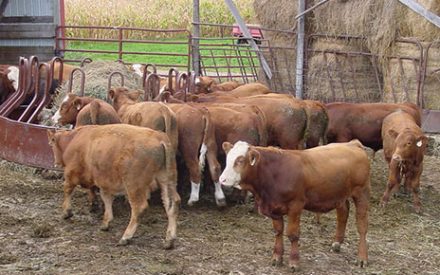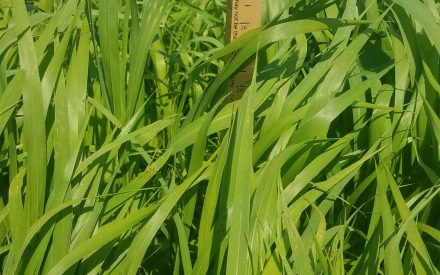Originally published in the Iowa Forage and Grassland Council November 2023 Newsletter
Forage species selection was underway to fit into the Natural Resource Conservation Service (NRCS) Environmental Quality Incentives Program (EQUIP) plan created to rejuvenate a small pasture on my farm. A work trip to Florida was the most unlikely place to discuss the annual forage crops that would be selected to fit the needs of the diverse species grazing the pasture before reseeding with a perennial seed mix the following year. Then it happened: eye contact with a sales representative at a tradeshow booth! Quickly, I looked at the booth to understand what type of conversation may be ensuing. Forage crops, sure, I can chat briefly and move on. Underestimating this particular business representative’s skills and passion, I outlined the entire EQUIP plan, including the sheep, cows, and horses. Dazed with brochures, business cards, and contact information for an Iowa representative in hand, one word stuck: CRABGRASS!

No, not the crabgrass that robs summer hours to be pulled and pried from flower and vegetable gardens just to regrow from a missed stubborn stolon. Not the prostrate crabgrass that creates a perfect matted circle rooted down at intervals, claiming its right to grow despite every effort to mow it off. But an “improved” variety to feed livestock. An improved variety to increase forage production and fill in the dry summer slump.
Dazed with brochures, business cards, and contact information for an Iowa representative in hand, one word stuck: CRABGRASS!
Typically grown in the southern United States, Digitaria cilaris (southern crabgrass) has been in the improvement stages of development for the past 35 years (Trammell & Butler, 2020). Recent forage cultivars boast high production (yields of 4,000-12,000 pounds per acre), are highly palatable, and are broadly adapted to various soil types, grazing and harvesting methods, and crop rotations (Trammell & Butler, 2020).
Forage crabgrass needs warm soil temperatures, 65℉, to germinate. This timing works well for planting after harvesting cover crops, where winter damage has occurred in hay fields, or for planting winter sacrifice pastures. The small seeds require a clean seedbed, shallow planting, and a roller to ensure adequate seed-to-soil contact (Newman, 2019).
Forage crabgrass emerges quickly and is ready for grazing at four to six inches tall in approximately 40 days (King, 2019). The stand quickly regrows and can be grazed several times until frost. Trails have found stockers to gain 1.5 to 2.0 pounds per day (Siller & Hashemi, 2022). To be productive in the hot and dry summer season, plants produce large root systems for water uptake, which also helps decrease soil erosion. Unlike many annual forage crops, forage crabgrass does not contain prussic acid. However, after a frost, it loses palatability.
As a hay crop, forage crabgrass can make two or more hay cuttings for many livestock types, including horses, due to its low sugar content (Siller & Hashemi, 2022). The fine leaf and stem harvested in the heading stage can have crude protein amounts as high as 15% CP and 60% total digestible nutrients (TDN). Forage crabgrass grows and matures quickly; therefore, producers must keep a keen eye out for stem size, as larger stems will increase the drying time. When allowed to produce seed later in the fall, the seed is persistent, behaving more like a perennial crop. Again, the seedbed will need to be rolled for proper seed germination.
Remember, not all crabgrass is a weed, and sometimes, taking a moment to strike up a conversation about a different way of production can be an innovative way to increase forage productivity, accommodate the nutritional needs of animals during the summer slump, and incorporate annual forage crops into a more extensive cropping system.
Resources and More information
Newman, Y. (2019, November 27). Forage crabgrass finds the road north. Hay & Forage Grower. https://www.hayandforage.com/article-2770-forage-crabgrass-finds-the-road-north.html
Pedreira BC, Yasuoka JI, Barros ITMD, Helwig D, Farney JK, Sassenrath GF. (2023). Management strategies to improve forage accumulation and nutritive value in crabgrass hayfields. The Journal of Agricultural Science 1-8. https://doi.org/10.1017/S0021859623000485
Trammell, M. & Butler, T. (2020, May 19). Forage crabgrass, Bob Dylan, and the changing times. Hay & Forage Grower. https://hayandforage.com/article-3022-forage-crabgrass-bob-dylan-and-the-changing-times.html
Siller, A. & Hashemi, M. (2022). Evaluating yield and quality of new upright crabgrass varieties as a summer forage in the Northeast. Crop, Dairy, Livestock, & Equine Newsletter. UMass Extension. V22, n6. cdle_spring_2022_newsletter_final.pdf (umass.edu)


 Do You Have Enough Forage? Four Steps to Figure Forage Inventory
Do You Have Enough Forage? Four Steps to Figure Forage Inventory Annual Forages Provide Options
Annual Forages Provide Options Fall Pasture Weed Control
Fall Pasture Weed Control Spring pasture weed management
Spring pasture weed management


